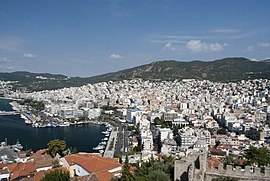Kavala
|
Kavala Καβάλα |
|
|---|---|

Panoramic view
|
|
| Coordinates: 40°56′N 24°24′E / 40.933°N 24.400°ECoordinates: 40°56′N 24°24′E / 40.933°N 24.400°E | |
| Country | Greece |
| Administrative region | East Macedonia and Thrace |
| Regional unit | Kavala |
| Area | |
| • Municipality | 351.4 km2 (135.7 sq mi) |
| • Municipal unit | 112.6 km2 (43.5 sq mi) |
| Highest elevation | 53 m (174 ft) |
| Lowest elevation | 0 m (0 ft) |
| Population (2011) | |
| • Municipality | 70,501 |
| • Municipality density | 200/km2 (520/sq mi) |
| • Municipal unit | 58,790 |
| • Municipal unit density | 520/km2 (1,400/sq mi) |
| Community | |
| • Population | 56,371 (2011) |
| Time zone | EET (UTC+2) |
| • Summer (DST) | EEST (UTC+3) |
| Postal code | 65x xx |
| Area code(s) | 2510 |
| Vehicle registration | KB |
| Website | http://tourism.kavala.gov.gr/web/guest/home |
Kavala (Greek: Καβάλα, [kaˈvala]) is a city in northern Greece, the principal seaport of eastern Macedonia and the capital of Kavala regional unit.
It is situated on the Bay of Kavala, across from the island of Thasos and on the Egnatia motorway, a one-and-a-half-hour drive to Thessaloniki (160 kilometres (99 miles) west) and a forty-minute drive to Drama (37 km (23 miles) north) and Xanthi (56 km (35 miles) east).
In Antiquity the name of the city was Neapolis ('new city', like many Greek colonies). During the Middle Ages, it was devoutly renamed Christoupolis ('city of Christ').
The etymology of the modern name of the city is disputed. Some mention an ancient Greek village Skavala near the town. Other proposals include either from the Italian cavallo (= horse), or from the Hebrew Kabbalah due to the city's large Jewish population in the past. Its nickname is The cyan city (Η γαλάζια πόλη).
The city was founded in the late 7th century BC by settlers from Thassos. It was one of several Thassian colonies along the coastline, all founded in order to take advantage of rich gold and silver mines, especially those located in the nearby Pangaion mountain (which were eventually exploited by Phillip II of Macedonia).
Worship of Parthenos / the Virgin, a female deity of Greek–Ionian origin associated with Athena, is archaeologically attested in the Archaic period. At the end of the 6th century BC Neapolis claimed independence from Thassos and began issuing its own silver coins with the head of Gorgo (γοργὀνειο) on one side. A few decades later a large Ionic temple made from Thassian marble replaced the Archaic one. Parts of it can now be seen in the town's archaeological museum.
...
Wikipedia


